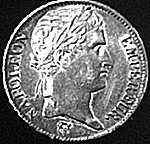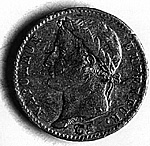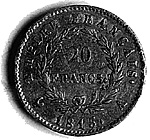When Napoleon returned to Paris from his exile on the island of Elba and resumed control of the government in March 1815, he was confronted with the immediate need to raise revenue to prepare for the possibility of renewed hostilities with his former foes. The rapid expansion of the French Army would require huge cash disbursements. The coins minted during those frantic days to help pay for these expenses are a unique marker in time of the "Hundred Days".
The French monetary system in use in 1815, established nearly twenty years earlier under the Directory, included only gold and silver major denomination coins. Due to the financial disaster of the paper assignats used during the early days of the French Revolution, paper money was not popular and the government in Paris had not issued any since the 1790s.
When the Bourbons returned to power following Napoleon's exile in March 1814, the portrait of Louis XVIII replaced Napoleon on French coins. With the return of Napoleon in 1815, the continued minting of coins with Louis on them was politically unacceptable.
To demonstrate that he now clearly controlled the government, it was important to Napoleon that any newly minted coins have his portrait on them, as they had prior to the first abdication. As Napoleon raised cash for the French military buildup, new coins, now with his picture, were introduced at a rapid pace.
The French mint masters, apparently either because they were slow or cautious to change, had not destroyed the old coin minting dies with Napoleon on them. Now that the Emperor was back, they merely had to take the old dies off the shelf and resume minting the old coins.
Within weeks of Napoleon's return, Paris and eight other French mints were striking three denominations of coins with the old portrait of "Napoleon Empereur" and the old motto "Empire Francais" and one coin with just the initial "N" on the obverse, all dated 1815.
The final denomination minted during the Hundred Days is a copper decime, of which 0.544 million were minted, with the letter "N" on the obverse, which is also about the size of a current U.S. half dollar.
Although not as obvious as the soldiers and weapons, the new money played a vital role in the events of the Hundred Days. Most armies will not fight for long if you do not pay them, and most contractors will stop providing supplies to the army if they are not paid. These four denomination of coins, plus the existing cash species in the government coffers, were rapidly spent as Napoleon's military buildup continued. The new coins soon ended up in the cash boxes of the firms providing supplies to the Army, and in the pockets of Napoleon's soldiers. Some of the newly minted coins undoubtedly ended up lying on the battlefield at Waterloo.
The mintage of these coins ended almost as quickly as it had begun. With Napoleon's defeat at Waterloo and the return of the Bourbons, the production of coins with Napoleon's portrait on them ceased, and the portrait of Louis returned. This final change in the currency was a powerful visual statement that Napoleon's reign and the period of the "Hundred Days" was truly over.
This article appears in MagWeb (Magazine Web) on the Internet World Wide Web. The coins available to most people and institutions were gold 20 and 40 francs and silver 1, 2, and 5 francs (1812 coin shown at right). The government issued paper bonds in only very big denominations to large scale investors. Otherwise the larger denomination coins were the primary monetary vehicle for government spending and commerce. (Note: a gold 20 franc coin represented wages for a skilled artisan for about 1 week, or two months pay for a conscript in the Army.)
The coins available to most people and institutions were gold 20 and 40 francs and silver 1, 2, and 5 francs (1812 coin shown at right). The government issued paper bonds in only very big denominations to large scale investors. Otherwise the larger denomination coins were the primary monetary vehicle for government spending and commerce. (Note: a gold 20 franc coin represented wages for a skilled artisan for about 1 week, or two months pay for a conscript in the Army.)

 The gold 20 franc coin (pictured), of which 9,823 million were minted, is about the size of a U.S. nickel and contains 0.187 ounces of gold. The silver 5 franc (also referred to as a silver crown), of which 5,104 million were minted, is the size of an old U.S. silver dollar and contains 0.7234 ounces of silver and was probably the most exchanged piece of money. The silver 2 franc, of which 6,783 million were minted, is about the size of a U.S. half dollar and contains 0.2893 ounces of silver.
The gold 20 franc coin (pictured), of which 9,823 million were minted, is about the size of a U.S. nickel and contains 0.187 ounces of gold. The silver 5 franc (also referred to as a silver crown), of which 5,104 million were minted, is the size of an old U.S. silver dollar and contains 0.7234 ounces of silver and was probably the most exchanged piece of money. The silver 2 franc, of which 6,783 million were minted, is about the size of a U.S. half dollar and contains 0.2893 ounces of silver.
Back to Table of Contents -- Napoleon #8
Back to Napoleon List of Issues
Back to MagWeb Master Magazine List
© Copyright 1997 by Emperor's Press.
The full text and graphics from other military history magazines and gaming magazines are available at http://www.magweb.com